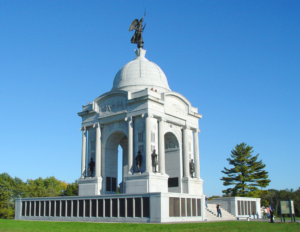
Monica Weber Babcock shares with us the mystery of her great-great-grandfather, a Union Civil War veteran. Monica is the author of the poetry collection Heartscape (available from Amazon) and is completing her first novel.
Mystery always shrouded my great-great-grandfather, a veteran of the Civil War. Although Mom knew the particulars about his family, she didn’t know even his first name.
My years of research yielded only a few clues. Samuel Maloney emigrated from Ireland, aged 18, in 1847; served in the 73rd Pennsylvania Volunteer Infantry, F Company; was listed in the 1880 Census as living with his wife and four children in Gloucester City, New Jersey.
In 2006, National Archives and Records Administration rewarded my desperate inquiry with a 74-page document, and I was able to construct the story of Samuel Maloney.
Samuel Maloney enlisted 9/3/1861 and was promoted to corporal four months later. After fighting at Cross Keys and Second Bull Run, he was shot in the right index finger during a skirmish in Falmouth, Virginia. Following his slog in the Mud March, a miserable, failed Union offensive in central Virginia in January 1863, Maloney suffered “spitting of blood, hemorraghe of the lungs, hard palpitations of the Heart … violent palpitations & faintings.” Yet, that April he was promoted to sergeant. He survived Chancellorsville.
At Gettysburg, while defending Cemetery Hill, he was shot “through the fleshy part of the left arm, above the elbow,” either by sniper fire or while protecting Weidrich’s Batteries. Hospitalized in Philadelphia, he experienced “violent palpitations, pains in both sides, feels like he will fall down, loses speech and eyesight, suffers weakness.” In December, he was diagnosed with “Irritable heart” and “Functional Cardiac Disorder.” The following month, he deserted for two weeks before returning to duty and was demoted to private. He was honorably discharged November 30, 1864.
In 1868, Samuel married Julia. My great-grandmother Sarah and her three siblings were born. Samuel was awarded a $2 monthly pension for wounds and “feeble irritable heart which he alleges is incident to the service.” An 1876 diagnosis of tuberculosis led to his admission, in August 1878, to the National Home for Disabled Volunteer Soldiers in Dayton, Ohio, where he died and was buried January 13, 1879.
So, why does the 1880 Census list him as alive?
I found the disturbing clue at the Dayton Soldier’s Home, when I visited in 2009. Upon admittance, Samuel listed himself as ‘widower.’
Why would he disown his wife and four children, ages 10, 8, 6, and 4?
I reexamined the National Archives packet, noting that Julia didn’t file for family survivors’ pensions until ten years after Samuel’s death. Clearly, he travelled to Dayton without her knowledge, and the Soldier’s Home had no record of a wife to contact. How Julia finally discovered she was a widow is anyone’s guess.
The ravages of PTSD could explain why this survivor of the horrors of the Irish Famine and the American Civil War abandoned his family, leaving a legacy of mystery. Samuel’s diagnoses of “Irritable Heart” and “Functional Cardiac Disorder” were the prevailing terms for PTSD, and his symptoms corroborate this. Also suffering tuberculosis, Samuel was physically and mentally a broken man.
Not only his society, but his family couldn’t comprehend his anguish. For them, his actions were shameful, and therefore hushed.
Mom, whose curiosity about her mysterious ancestor set me on this task, sadly passed away in 2001, before I could uncover any of these facts. Ironically, one of her favorite places was Gettysburg, where our family visited the Pennsylvania State Memorial, never knowing her great-grandfather’s name was proudly engraved on the Seventy-Third Pennsylvania’s bronze tablet. Read reports on Lincoln’s Gettysburg Address
Photo via Gettysburg.StoneSentinels.com.
Thank you for this fascinating, moving story, Monica.
These things are so complicated and there are so many potential explanations for what happened.
You found out an amazing amount of information about this intriguing family story.